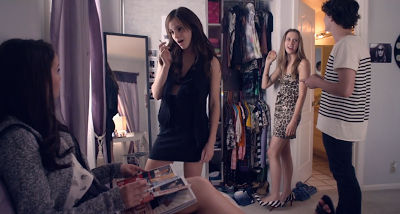It's rather wonderful for a huge blockbuster to focus its attention on relationships, not romantic endeavors, that would be cliched, out of place, and drive away the target audience, but relationships between brothers and sisters, fathers and sons, friends and colleagues. Every character in the movie has a counterpart. All characters, at some point, come to realize that working alone is foolish and that the only way to defeat the giant beings attacking our dear planet Earth is to stand together. Simplistic, perhaps, but powerful nonetheless.
The movie begins by quickly telling the story of how giant beasts attacked the earth. In a spectacular opening shot, we see a beautiful night sky and hear a narrator saying that he used to look up at the stars every night wondering if there were other beings out there. But he admits he was wrong. As it turns out the "kaiju," as the beasts are called, came from the sea. As he reveals this, the shot transitions from what seemed as stars moments ago to show that those white specks are instead bubbles of air deep within the pacific ocean. Instants later, a kaiju comes soaring up towards San Francisco to devour the Golden Gate bridge. For a while, all seems lost.
To battle the kaiju, humans created "jaegers," giant mechanical warriors that can be linked to the mind of its pilots. Pacific Rim would be worth it simply to see the breathtaking design of the jaegers which are made to look like hybrids between World War II fighter planes and Transformers. Each jaeger, however, requires two pilots to control since a jaeger is too big for one mind to control.
As a result, director Guillermo Del Toro is able to anchor the massive un-relatable struggle between titanic creatures to the growing relationship between pilots who must share thoughts and memories while connected to their jaeger, particularly Raleigh, a veteran, though young ace pilot who lost a copilot while connected to him, and Mako, an eager, brilliant, student of jaegers who longs to prove herself as a pilot. Charlie Hunman infuses Raleigh with his usual, effortless charm to make a character who could have easily been a Tom Cruise-style arrogant maverick pilot into an immensely likable character with unexpected gravitas due to his past tragedy shown on the prologue of the film.
 |
| Raleigh (left) and Mako (right) |
This isn't a movie of humanity defending earth. Instead, like The Matrix, it is a movie about a defeated people struggling for its survival. This gives most, if not all, characters in the movie deep cynicism since few actually believe they can defeat the kaiju. As a result they are divided and mistrustful, especially a young Australian jjaeger pilot, Chuck Hansen, and a black-market kingpin, Hannibal Chau, played wonderfully as a coward-with-tough-guy-exterior by Del Toro regular Ron Pearlman (aka Hellboy). One learns how to cooperate with is peers and becomes a hero for humanity; the other gets eaten by a baby kaiju.
 |
| Hannibal Chau |
Other key relationships include one between a couple of scientists, used mostly for comic relief, trying to figure out the best way to defeat the kaiju as well as the relationship between Mako and her surrogate father Marshall Stacker Pentecost (Idris Elba) who also serves as the leader of the resistance and a unifying link among all characters. Idris Elba has such a commanding presence that by the time he gives his obligatory "today we're canceling the apocalypse" speech, I had to restrain myself from cheering and joining him in battle.
 |
| Idris Elba |
I'd be remiss if I didn't mention the battle sequences of Pacific Rim, which I admire, but Matt Zoller Seitz explained it best in his review:
Nitpicks aside, though, the fights are astonishing. They split the difference between classical filmmaking and the blurrier, more chaotic modern style in a way that made me appreciate the virtues of both. Some of the whirling action has a geometric beauty that's faintly Cubist, and each fight contains surprises: a tactic you haven't seen yet, a power you didn't know about, a complication you didn't see coming.
He also takes a beautifully crafted paragraph to praise some of Del Toro's gorgeous visuals:
There are many shots so striking that they could have served as the poster image: A Jaeger tumbling into an abyss, its E.T. heart pulsing; a little girl's red shoe in a grey ash-heap on a rubble-strewn street; a kaiju unfurling kite-like wings; a one-eyed kaiju-body-parts dealer named Hannibal Chau (Ron Perlman) stalking through wreckage, his steel-tipped dress shoes jangling like cowboy spurs. A simple shot of Elba's character taking off a helmet is infused with such emotion, thanks to its placement in the story and the sunlight haloing the actor's head, that it would have made John Wayne cry.
"If I were nine years old" Seitz writes, "I would see Pacific Rim 50 times." I agree, but, like him, "I'll have to be content with seeing it a couple more times in theaters and re-watching it on video."
Verdict- 3.5/4
Pacific Rim (2013) 2h 11min. PG-13.
Random Thoughts:
- I am convinced that Idris Elba should be the next James Bond.
- Every time I see Idris Elba in a movie I think of his 40 degree day speech in The Wire. Warning, it contains strong language.
- Iron Man 3 and Man of Steel were like 40 degree days. Pacific Rim, thankfully, was closer to a 60 degree day.








